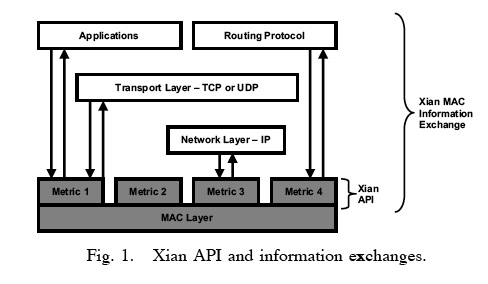Within the wireless node, cross-layer communication is implemented on a Request/Response model. Upper layers or communication system components can thus access individual metrics provided by the 802.11 MAC layer. The purpose is to propose an open crosslayer implementation which supports the largest possible class of experimentations in domains such as QoS signalling, ARQ/FEC mechanisms, end-to-end transport protocols, adaptive applications, scheduling algorithms, routing predictions or bit rate adaptations.

The metrics offered by the implementation of the MadWifi driver can be clustered in three groups:
- Configuration states, which mainly concerns the current configuration parameters of the 802.11 network device, such as the used channel or the number of queues.
- Aggregated metrics, similar to counters, this kind of metrics provides global statuses on the use of the 802.11 network interface since it run;s first started. For example, the reported information can be: the number of received frames dropped or with wrong BSSID, the number of transmitted frames with CTS or with RTS enabled, the relative signal strength (RSSI) of the last ACK on transmission, the number of failed receptions (due to queue overrun, bad CRC, PHY errors or decryption problems).
- Per neighbour/link metrics, which stores per neighbour information related to particular transmission at MAC layer. For instance, this kind of metric relates the number of received/transmitted data frames or bytes, the relative signal strength (RSSI) or the number of transmission retries.